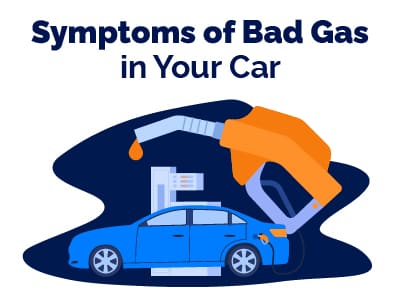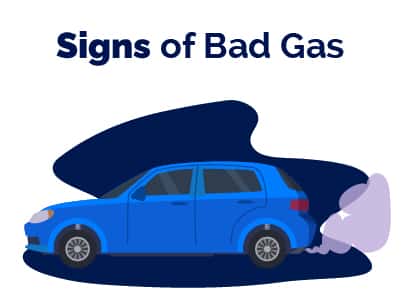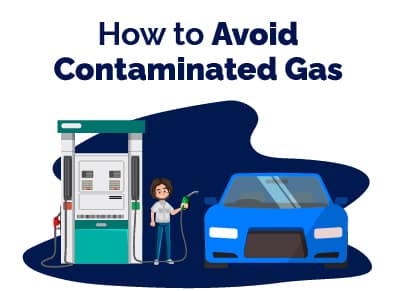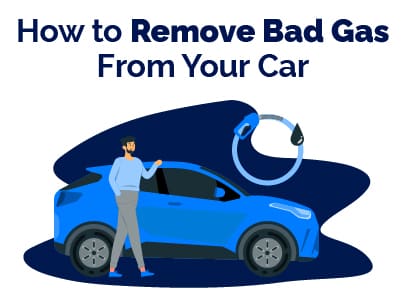Top 5 Symptoms of Bad Gas In Your Car (& How to Get Rid Of It)
February 7, 2024


Michael Collado is a car buying expert and has been a professional automotive writer since 2009. He’s written about dealership sales, vehicle reviews and comparisons, and service and maintenance for over 100 national automotive dealerships. Previously, Collado was a copywriter at the ad agency TBWA/Chiat/Day where he worked on brand campaigns for Nissan, ABC Television, Sony PlayStation, and Energizer. His recognition in the ad industry includes awards from Communication Arts and The Clios.
Collado has a Bachelor’s degree from the University of South Florida, with a major in Psychology and a minor in Marketing.
Are you having trouble with your vehicle’s performance? It may be the quality of the gas in your tank.
That’s why it is important to know the signs and symptoms of bad gas in your vehicle.
We'll take a look at what warning signs you should look out for. Additionally, we'll review how to get rid of bad gas from your tank.
Key Takeaways
The top 5 symptoms of bad gas in your car are:
- Engine stalling
- Engine start-up problems
- Lack of acceleration
- Check engine light is on
- Delayed gear shifting
- Burning more gas than usual
Table of Contents
Symptoms of Bad Gas in Car Video
What Causes Gas to Go Bad?
Gas can go bad if it sits in your tank for an extended period. Auto experts estimate that gas can go bad after three months. Over time, the gas begins to break down, making it less effective in the engine.
Signs Of Bad Gas In Your Car
Signs of bad gas can include engine stalling and startup issues, lack of acceleration, a lit check engine light, and more.

Engine Stalling
Stalling is when the engine slows down or no longer works. This can happen if you are attempting to drive with old or bad gasoline in the tank.
Engine Start-up Issues
Let’s say you had a car sitting in your garage for months. If you try to start up the vehicle, the gasoline may have degraded to a point that it will not be able to turn over the engine.
Lack of Acceleration
The quality of gasoline plays a big role in the performance of the vehicle. For instance, high octane gas is required for exotic sports cars. Therefore, if you are driving with bad gasoline, your engine will not have the proper fuel that it needs to deliver the desired acceleration.
Check Engine Light
Anytime there is an issue with the vehicle’s engine, your vehicle’s check engine light will come on. This can typically happen when you are driving with bad gasoline in the vehicle. When this happens, you should go to a service center and have the vehicle inspected with a diagnostic scan tool.
Delayed Gear Shifting
Bad gasoline will affect just about every part of your vehicle’s performance, including the transmission and the vehicle’s ability to shift gears. If you notice that gears are slipping, then check the gas.
Burning More Gas
Bad gas will be diluted and it will not be as effective as good gasoline. Therefore, you will need to burn more gas just to maintain the normal operation of the vehicle. This could lead to more trips to the fuel station.
How to Avoid Contaminated Gas
You don’t want to end up with contaminated gas in your vehicle. Therefore it is important to take the right steps to avoid contaminated gas:
 Avoid Leaving Gas in Your Tank for More Than Three Months
Avoid Leaving Gas in Your Tank for More Than Three Months
If you are planning to garage or store your vehicle for more than three months, then drain the tank.
Use High-Quality Gas
It is always a good idea to use high-quality gas. This is especially true if you drive a high-performance vehicle. The better the gas, the better the performance.
Use a Fuel Additive
Add a fuel additive that can help protect the quality of the gas in your tank.
Testing for Bad Gas
Make sure you know when you have bad gas in your vehicle. You can test for bad gas by swapping the gas and checking how much water is in the gasoline. If there is a higher than usual concentration of water in the gas, then it is considered “bad” and the vehicle gas tank will need to be drained.
How To Test For Bad Gasoline
If you suspect that your vehicle's performance issues may be due to bad gasoline, test and confirm your suspicions. Follow this step-by-step guide to test for bad gasoline:
Step 1: Gather supplies
To test for bad gasoline, you need a few supplies:
- a clean, empty glass container with a lid (such as a mason jar)
- a sample of the suspect gasoline
- a gasoline test kit available at most automotive supply stores.
Step 2: Prepare the container
Ensure that the glass container is clean and free from any contaminants. Use a glass container as some plastic containers may react with gasoline, affecting the accuracy of the test.
Step 3: Collect a gasoline sample
Using a fuel-safe container, carefully extract a sample of the suspect gasoline from your vehicle's fuel tank. Be cautious not to spill or contaminate the sample during the collection process.
Step 4: Perform the water separation test
Open the gasoline test kit and carefully follow the instructions provided. Most kits involve mixing a specific amount of gasoline with water and observing the results. Typically, bad gasoline will cause the water and gasoline to separate, resulting in distinct layers.
Step 5: Check for sediment or debris
Examine the gasoline sample for any sediment or debris that may have settled at the bottom of the container. If you notice particles or impurities, it could be a sign of bad gasoline.
Step 6: Smell and inspect the gasoline
Take a moment to smell the gasoline sample. Bad gasoline often emits a strong, pungent odor. Additionally, visually inspect the gasoline for any unusual coloration or cloudiness.
Step 7: Compare with fresh gasoline
To verify your findings, obtain a sample of fresh, uncontaminated gasoline from a trusted source. Perform the same tests outlined above on the fresh gasoline and compare the results with your suspect sample.
Step 8: Seek professional assistance
If the tests indicate that the gasoline is indeed bad, consult a professional mechanic or technician. They can provide further analysis, diagnose any potential vehicle issues caused by the bad gasoline, and guide you in the appropriate steps for resolution.
How To Get Water Out Of Gas
Here is how you can remove water from gas:
Park your vehicle in a well-ventilated area
Park your vehicle in a safe location with good ventilation. Performing the water removal process outdoors or in a well-ventilated garage prevents the harmful fumes from building up.
Disconnect the fuel pump fuse or relay
Locate the fuel pump fuse or relay in your vehicle's fuse box. Disconnect the fuel pump to stop fuel circulation.
Drain the gas tank
Locate the drain plug on your gas tank. The location may vary depending on the make and model of your vehicle. Use a wrench or pliers to remove the drain plug and allow the water-contaminated gasoline to drain completely into a suitable container.
Dispose of the contaminated gasoline
Properly dispose of the water-contaminated gasoline in accordance with local regulations. Contact your local waste management facility or hazardous waste disposal center for guidance.
Inspect the fuel filter
Check the fuel filter for signs of water or debris. If the filter is visibly contaminated, replace it with a new one to ensure optimal fuel flow and prevent any potential issues down the line.
Add a fuel additive
Purchase a fuel additive designed to remove water from the fuel system. Add it according to the instructions. The additive helps eliminate any remaining traces of water and prevent further accumulation.
Refill the gas tank
With the drain plug securely back in place, refill the gas tank with fresh, uncontaminated gasoline. This dilutes any remaining water and ensures proper fuel combustion.
Reconnect the fuel pump fuse or relay
Reconnect the fuel pump fuse or relay to restore fuel circulation in your vehicle. Start the engine and allow it to run for a few minutes. This ensures that the fresh gasoline and fuel additive circulate.
How to Remove Bad Gas From Your Car
Once you have determined that there is bad gas in your tank, you will need to have the gas tank drained. Here is the four-step process to getting the job done.
 1. Remove Gas Tank
1. Remove Gas Tank
The first thing that you will need to do is remove the gas tank from the vehicle.
2. Siphon Gas From the Tank
After the gas tank has been removed, then a siphoning tube can be used to remove the gas from the tank until the tank is completely emptied.
3. Add Dry Gasoline
Now add dry gasoline. This is an alcohol-based additive that helps treat gas tanks that have been contaminated.
4. High Octane Gasoline
Finally, fill up your gas tank with high-octane gasoline. Even if you don’t have a high-performance vehicle, give your engine the highest quality gas possible to ensure provide better performance.
Conclusion
Bad gas won't properly combust, leading to several noticeable signs in your vehicle. If your car is struggling to start, stalling, or showing reduced fuel economy, then you should test your gasoline. Use a gas testing kit or seek the help of a mechanic.
To prevent bad gas, don't leave your car sitting, unused for over three months. Add an additive to help preserve gas, and regularly monitor your fuel economy.
Looking for more car care tips? Read more at https://www.findthebestcarprice.com/.
Best Car Deals by Category
Frequently Asked Questions
How does a car act when it has bad gas?
A vehicle with bad gas may have problems starting and accelerating. It may not run smoothly, and may consume fuel faster than normal.
Can bad gas ruin an engine?
Yes, driving with bad gas can damage the engine components. If you suspect you have bad gas, do not turn over the engine.
Can bad gas damage your car?
Bad gas can damage your vehicle by degrading performance. Also, bad gas can cause issues with the fuel filter and the fuel pump. That’s because the fuel filter can become dirtier faster. Also, the fuel pump may have to work harder to feed gas to the engine.
How can bad gas damage your car?
Bad gas can potentially damage your car by causing poor engine performance, damage to the fuel injectors, and engine deposits. The contaminants in bad gas may clog the fuel injectors and filter. In severe cases, the entire fuel system may need repairs or replacement, leading to costly maintenance.
Can you get reimbursed for bad gasoline?
If you can prove that you received bad gasoline from a fuel station, then you should be able to be reimbursed for the price of the gas. However, you may have to pursue legal action to be compensated for any damage to the vehicle.
What are the symptoms that you have water in your tank?
Symptoms of bad gas in your tank include engine stalling, failure for the engine to start up, decreased acceleration, declared fuel efficiency, a check engine light, and delayed gearshifting.
What is the best type of gas for most cars?
For most vehicles, that will be gas with an octane rating of 89 or better.
What happens if you drive with bad gas?
If you drive with bad gas in your car, you can experience decreased performance. Over time, you can damage parts of your vehicle such as the fuel filter and the fuel pump.
What to do if you get bad gas in your car?
If you get bad gas in your car, remove it as soon as possible. Avoid starting the engine or attempting to fix the issue yourself, as it may cause further damage. A qualified mechanic can drain and clean the fuel system, and assess if any repairs are needed.
Posted in Car Troubleshooting |





